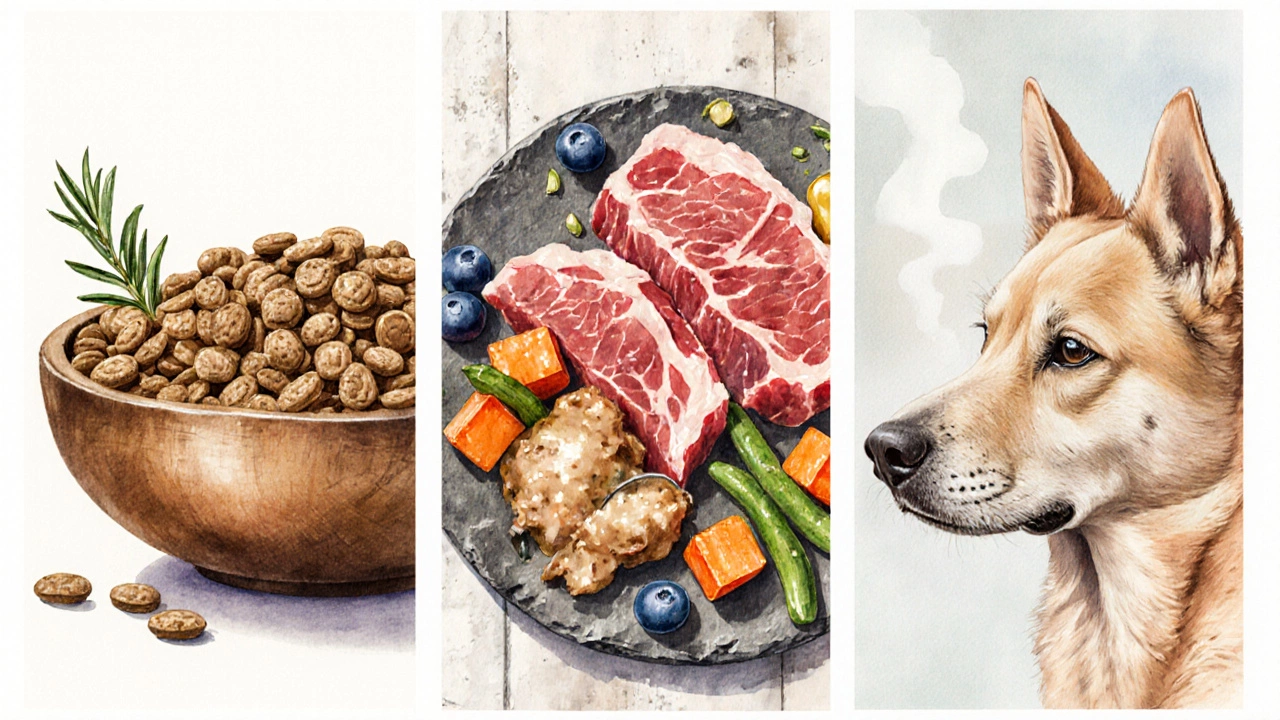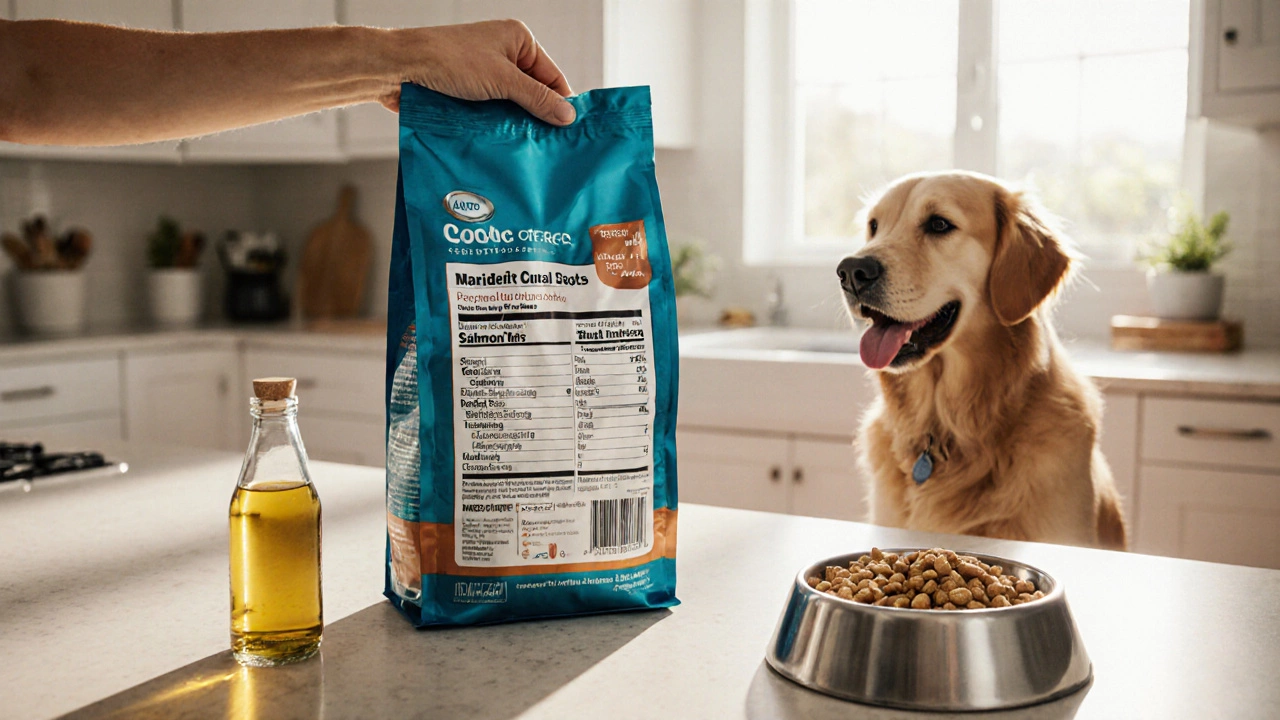Quick Takeaways
- Look for AAFCO‑approved healthy dog food with 18%+ protein for adults.
- Whole‑food proteins, omega‑3 fats, and limited fillers give the best health boost.
- Raw meat diets, high‑quality kibble, and home‑cooked meals each work when matched to your dog’s life stage.
- Read labels for real‑meat first, named fat sources, and added glucosamine for joint support.
- Consult a veterinary nutritionist before major diet changes.
Choosing what to put in your dog's bowl can feel overwhelming. Between shiny bags, trending raw‑food videos, and endless "grain‑free" claims, it's hard to know which option truly supports longevity, shiny coats, and happy digestion. This guide breaks down the science behind a healthy diet, shows how to read those tiny label lines, and offers practical meal ideas so you can feed your pup with confidence.
What a Dog Really Needs
Unlike humans, dogs aredog food a complete, balanced source of protein, fat, carbohydrates, vitamins, and minerals formulated to meet canine nutrition guidelines. Their bodies thrive on high‑quality animal protein, moderate fat for energy, and just enough carbs to keep blood sugar stable. Essential fatty acids-especially omega‑3s-support brain health and a glossy coat, while minerals like calcium and phosphorus keep bones strong. The American Association of Feed Control Officials (AAFCO the organization that sets nutritional standards for pet foods in the United States and Canada) outlines minimum percentages for these nutrients, and any food bearing the AAFCO statement has met those baseline levels.
Key Ingredients to Look For (and Avoid)
When you scan a bag, focus on the first three ingredients. Real meat (chicken, beef, lamb, fish) or meat meals (e.g., chicken meal) should top the list. Follow that with a named fat source like "salmon oil" or "chicken fat"-these deliver the omega‑3s and omega‑6s dogs need in the right ratio.
- Omega‑3 fatty acids essential fats that reduce inflammation and improve skin and coat health: look for fish oil, flaxseed, or algae.
- Protein content percentage of protein on a dry‑matter basis, ideally 18‑30% for adult dogs.
- Limited‑ingredient diets: good for dogs with food sensitivities; they list fewer protein sources and avoid common allergens like corn, wheat, and soy.
- Grain‑free options: not always healthier; many rely on high‑glycemic legumes that can stress the pancreas.
Avoid vague terms such as "meat and bone meal" without a clear animal source, and watch out for excessive fillers like corn gluten, wheat bran, or pea protein that add calories but little nutritional value.

Popular Healthy Food Types
| Food Type | Pros | Cons | Key Nutrients |
|---|---|---|---|
| Commercial dry kibble | Convenient, long shelf‑life, often AAFCO‑approved | Can contain fillers; quality varies by brand | Balanced protein 18‑30%, added vitamins, omega‑3s (if fortified) |
| Raw meat diet | Maximum meat content, natural enzymes, high moisture | Risk of bacterial contamination; requires careful supplementation | Protein 70‑80%, natural omega‑3s, minimal carbs |
| Home‑cooked meals | Control over ingredients, can be tailored to health issues | Time‑consuming; must balance calcium/phosphorus | Variable protein, includes vegetables for fiber, can add fish oil |
| Limited‑ingredient diet | Reduces allergy triggers, simple ingredient list | May be pricier; limited protein sources | High‑quality single protein source, balanced fats |
| Grain‑free diet | Often marketed for sensitive stomachs | Recent studies link some grain‑free formulas to heart disease | Often high in legumes; ensure adequate taurine |
How to Read a Dog Food Label Like a Pro
Start with the "Guaranteed Analysis"-this tells you the minimum protein and fat percentages, plus maximum fiber and moisture. A good adult diet hits at least 18% protein and 8% fat on a dry‑matter basis.
- Check the AAFCO statement. If it reads "Formulated to meet the nutritional levels established by the AAFCO Dog Food Nutrient Profiles for maintenance," you’re covered for basic needs.
- Identify the protein source. Whole meat > meat meal > by‑product meal.
- Look for added functional ingredients: glucosamine for joints, probiotics for gut health, or antioxidants like blueberries.
- Verify the calorie content (kcal/kg). Over‑feeding high‑calorie kibble can lead to obesity.
- Confirm the batch/lot number and expiration date-freshness matters.
Matching Food to Your Dog's Life Stage and Health
Puppies need 22‑32% protein to support rapid growth, while seniors benefit from joint‑support nutrients and slightly lower calories to avoid weight gain.
- Small breeds (under 20 lb): tiny kibble size, higher calorie density.
- Large breeds (over 50 lb): formulas with controlled calcium to protect growing joints.
- Active dogs: higher fat (12‑15%) and added glucosamine.
- Dogs with allergies: limited‑ingredient or novel‑protein diets (e.g., venison, duck).
- Heart‑sensitive breeds: ensure sufficient taurine and avoid certain grain‑free recipes linked to dilated cardiomyopathy.
Sample Week‑Long Balanced Meal Plan
Below is a simple plan mixing high‑quality kibble with fresh toppers. Adjust portions using your vet’s calorie recommendation.
- Monday - 1 cup kibble + ¼ cup boiled chicken breast + 1 tbsp pumpkin puree.
- Tuesday - 1 cup kibble + 2 tbsp plain Greek yogurt (probiotic boost).
- Wednesday - 1 cup kibble + ½ cup steamed green beans + 1 tsp salmon oil.
- Thursday - 1 cup kibble + ¼ cup lean ground turkey (cooked, no seasoning).
- Friday - 1 cup kibble + ½ cup cooked sweet potato + 1 tbsp blueberries.
- Saturday - 1 cup kibble + ¼ cup cottage cheese (calcium).
- Sunday - 1 cup kibble + ½ cup mixed carrots & peas + 1 tsp olive oil.
Rotate protein sources every few weeks to keep meals exciting and cover a broader nutrient spectrum.
Common Pitfalls and How to Avoid Them
- Over‑relying on treats. Treats should be <10% of daily calories.
- Skipping veterinary guidance. Certain breeds need breed‑specific supplements.
- Assuming "grain‑free" = healthier. Check the actual protein source and watch for legumes.
- Neglecting water. Fresh water must be available at all times, especially with dry kibble.
Quick Checklist Before You Buy
- AAFCO‑approved ✔️
- Real animal protein as #1 ingredient ✔️
- Omega‑3 source (fish oil, flaxseed) ✔️
- Appropriate protein % for life stage ✔️
- No unnecessary fillers or artificial colors ✔️
- Positive reviews from reputable pet‑health sites ✔️
Is raw food really the healthiest option?
Raw diets provide maximum meat content and natural moisture, but they lack guaranteed nutrient balance. If you choose raw, supplement with calibrated vitamins, calcium, and omega‑3s, and practice strict hygiene.
Can a grain‑free diet cause heart problems?
Recent research links some grain‑free formulas high in peas or lentils to dilated cardiomyopathy in susceptible breeds. Choose grain‑free foods that include added taurine or consult your vet.
How much should I feed my 30‑lb adult dog?
A typical 30‑lb dog needs about 900-1100 kcal per day. Check the bag’s kcal per cup and adjust portions to meet that range, factoring in activity level.
What are the signs my dog isn’t getting enough nutrients?
Dull coat, chronic skin itch, low energy, frequent soft stools, or unexplained weight loss can all signal nutrient gaps. A vet‑run blood panel can pinpoint deficiencies.
Are home‑cooked meals safe for long‑term feeding?
Yes, if you follow a balanced recipe verified by a veterinary nutritionist. The biggest risk is missing calcium‑phosphorus ratios, which can lead to bone issues.







